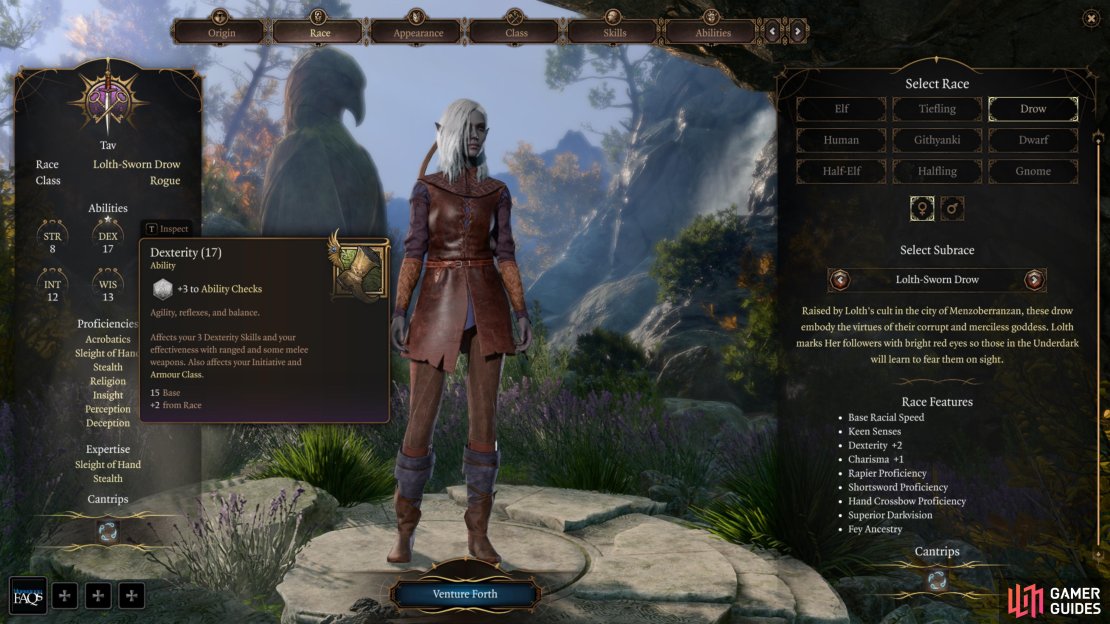Dexterity is one of the six Ability Scores that define a character’s physical and mental attributes. In Dungeons and Dragons, Ability Scores for player character races generally range from 3-18 - the result of rolling 3d6. In Baldur’s Gate 3, your player character’s starting Ability Scores will range from 8-15 by default, with racial modifiers potentially boosting them up to 17. On their own, Ability Scores don’t directly influence anything, but the higher an Ability Score is, the higher its associated modifier will be, and different Ability Score modifiers cumulatively affect just about every aspect of the game, including Attack Rolls, Damage Rolls, Skill Checks, Saving Throws, spell potency, and many, many more core aspects of the game. This page will explain what the Dexterity Ability Score does in Baldur’s Gate 3.
Dexterity influences your Attack Rolls and Damage Rolls with ranged weapons and melee weapons with Finesse, boosts your Armor Class and Initiative Rolls, and contributes to Acrobatics, Sleight of Hand and Stealth skills.
What Does Dexterity Do In Baldur’s Gate 3¶
Agility, reflexes, and balance.
Affects your 3 Dexterity Skills and your effectiveness with ranged and some melee weapons. Also affects your Initiative and Armour Class.
-
Skills: You add (or subtract) your Dexterity modifier from your Acrobatics, Sleight of Hand and Stealth skills. Acrobatics helps you keep your balance on slippery or narrow surfaces and helps you resist being shoved. Sleight of Hand is something of a catch-all skill for a variety of old Rogue abilities, most notably picking locks, stealing from other characters and disarming traps. Stealth determines your ability to move about undetected, allowing you to get into all kinds of mischief. Needless to say, if you want to play the archetypal “thief” character, you’re going to want to be competent with these skills.
-
Initiative: When combat begins, every participant will roll a d20 and add their Dexterity modifier to the result to determine the order in which they’ll act - this is your Initiative. In a turn-based game, the characters who act first have a distinct advantage, making a high Dexterity modifier a welcome boon for any character.
-
Armor Class: You add your Dexterity modifier to your Armor Class, making it more difficult for enemies to land hits on you. Note that some types of armor impose Disadvantage when you’re attempting Stealth checks, and all heavy armor nullifies any Dexterity Bonus you’d otherwise add to your Armor Class, so if you plan to wear heavy armor, a high Dexterity score may not be all that beneficial, and if you have a high Dexterity score, you might want to avoid heavy armor.
-
Saving Throws: You add your Dexterity modifier to Dexterity Saving Throws.
-
Ranged Attack and Damage: Your Dexterity modifier is added to Attack Rolls and Damage Rolls made with ranged attacks, with the exception of thrown weapons, which use your Strength modifier. Obviously this makes Dexterity essential for archers or any other character who prefers to strike from afar (casters add their primary casting Ability Score to Attack Rolls with spells), but Dexterity can also substitute for Strength on some melee weapons - any weapon that has the “Finesse” trait.
Back in the foggy era of 2nd Edition Dungeons and Dragons, Dexterity was primarily a defensive stat that buffed some Rogue (back then called a “Thief”) skills, as well as improved the THAC0 (but not damage) of ranged weapons. Starting with 3rd Edition, however, Dexterity became a melee substitute and started influencing Saving Throws, a trend that has only deepened in the intervening two decades. Dexterity was always useful, but now it’s one of the more important stats in the game - a heavily-armored brute can ignore it with little ill effect, but it’s now entirely possible for a dexterous adventurer to pick up a rapier and do just fine.
Depending on your build, you’ll either want to have a high Dexterity (if you focus on Finesse weapons, ranged weapons, wear light or medium armor and want to make use of Acrobatics, Sleight of Hand and Stealth skills), a splash of Dexterity (elves can pretty easily get 14 Dexterity without burning too many points) or you’ll want to keep your Dexterity at 10 (you plan to use heavy weapons and wear heavy armor). Most characters will probably try to shoot for 12 or 14 Dexterity.
| Dexterity Score | Dexterity Modifier |
|---|---|
| 1 | -5 |
| 2-3 | -4 |
| 4-5 | -3 |
| 6-7 | -2 |
| 8-9 | -1 |
| 10-11 | 0 |
| 12-13 | +1 |
| 14-15 | +2 |
| 16-17 | +3 |
| 18-19 | +4 |
| 20-21 | +5 |
| 22-23 | +6 |
| 24-25 | +7 |
| 26-27 | +8 |
| 28-29 | +9 |
| 30 | +10 |

No Comments